

EIAs have been used increasingly around the world. In the United States, Environmental Impact Assessments obtained formal status in 1969, with the enactment of the National Environmental Policy Act (NEPA). EIAs provide technical evaluations that are intended to contribute to more objective decision making. An EIA is prepared to estimate the effects of a proposed development or construction project.

Environmental assessments may be governed by rules of administrative procedure regarding public participation and documentation of decision making, and may be subject to judicial review. It is a tool of environmental management forming a part of project approval and decision-making. In this context, the term " environmental impact assessment" ( EIA) is usually used when applied to actual projects by individuals or companies and the term " strategic environmental assessment" (SEA) applies to policies, plans and programmes most often proposed by organs of state. Environmental assessment ( EA) is the assessment of the environmental consequences of a plan, policy, program, or actual projects prior to the decision to move forward with the proposed action.


 0 kommentar(er)
0 kommentar(er)
